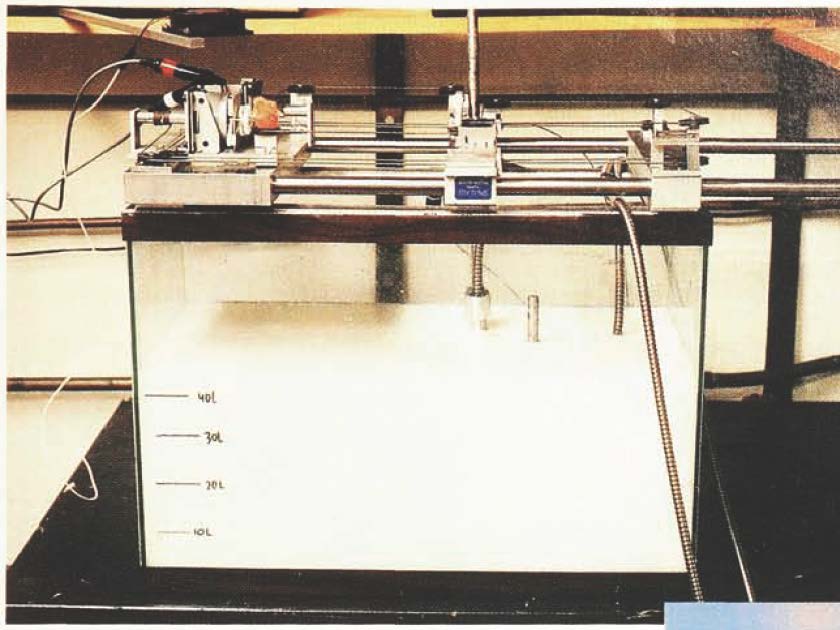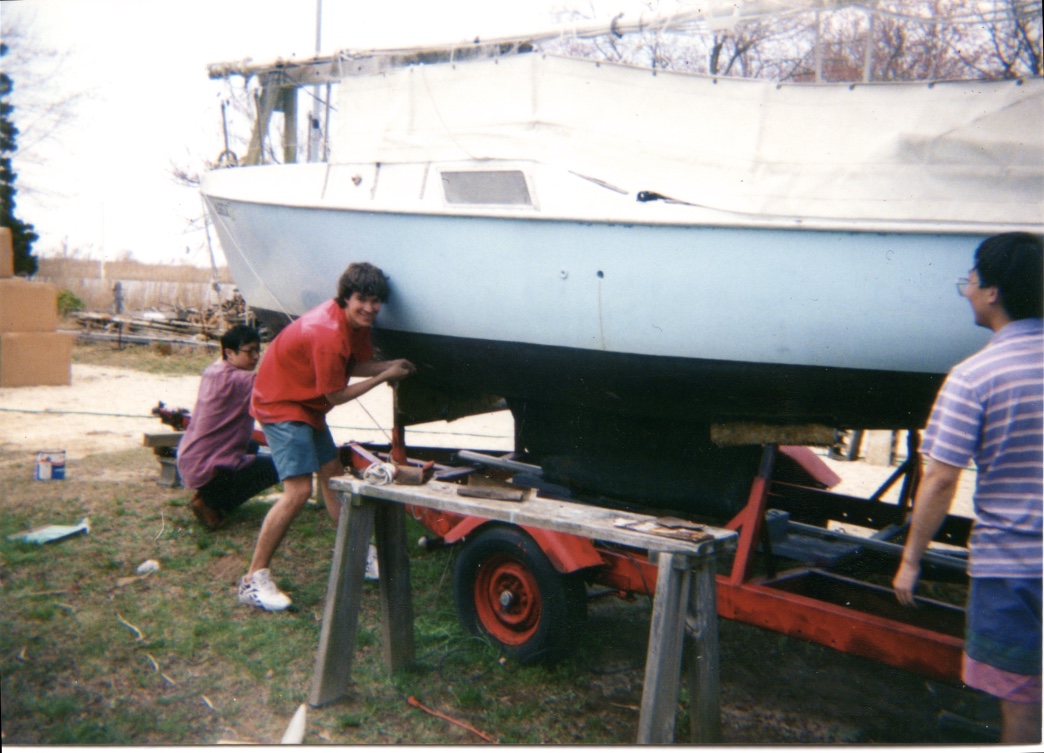The Daily Free Press recounts the HUBWeek event in which Center Director Bruce Rosen and medical illustrator Danny Quirk spoke about the intersectionality of human anatomy and visual art.
Zen And The Art Of Sailboat Maintenance: David Boas On The Early Days Of Biomedical Optics
 |
|
David Boas with Britton Chance, circa 2002
|
When David Boas steps on stage this month to receive the Britton Chance Biomedical Optics Award he will have, in a sense, come full circle.
Named for the biophysics pioneer who ushered in the use of light for biomedical applications—and presented by SPIE, the international society for optics and photonics, at the Photonics West conference in San Francisco—the award recognizes outstanding contributions to the field of biomedical optics, particularly through the development of innovative methods and devices.
David, a Professor of Radiology at Harvard Medical School and the Director of the Optics Division at the MGH Martinos Center for Biomedical Imaging, has had an immeasurable impact on the field—not least through the introduction and ongoing advancement of the imaging technique we now know as functional near-infrared spectroscopy (fNIRS). He has been working with this technique, developing it and continually refining it, for almost a quarter of a century, ever since he started his first job in the biophysics arena.
The man who gave him that job? You guessed it: Britton Chance.
I should note before going on, if only to explain my familiarity in using his first name, that David is my brother. We get together every Tuesday to catch up over dinner and maybe suffer a crushing video game defeat at the hands of my 10-year-old nephew. On a particularly cold Tuesday in January, after the dishes had been cleared and the games had been played, David and I sat down in the glow of a fire to talk about the early days of his career: the days when he was working with Chance and others to lay the foundation for an exciting new field of scientific research.
*****
In the spring of 1992 David was a first-year graduate student in the University of Pennsylvania Physics Department trying to decide on a project and on a focus for his studies. One day in a graduate seminar he heard Arjun Yodh, a professor in the department, describe using the scattering properties of light in the study of condensed matter (this is essentially what it sounds like: looking at how photons—the particles of light—scatter as they pass through a medium). Intrigued, David went to talk with Yodh about exploring this as part of his Ph.D. work.
As it happened, Yodh had recently met Chance, a fellow Penn professor. In the course of their conversation, Yodh and Chance discussed the possibility of applying Yodh’s novel optical methods to address challenges that Chance was facing with noninvasive biomedical applications. David’s timing, then, was impeccable. “A week later I walk into Arjun’s office saying I’m interested in working on light scattering,” he recalls with a laugh. Yodh sent David to Chance. Chance in turn offered him a job.
Here’s where things get a little heady. Enrico Gratton, a physics researcher at the University of Illinois at Urbana-Champaign, had just published a paper detailing the properties of something called a “diffuse photon density wave.” Gratton showed that this had a well-defined phase shift relative to the light source. Yodh had the idea to demonstrate that it also had other classical physical properties of a wave: namely, that it refracts when it encounters the boundary between two mediums with different scattering properties.
Over the next several weeks David and another graduate student, Maureen O’Leary, conducted a series of measurements that showed it in fact does. Everything about the study quickly fell into place, he says. “I think by my fifth week we submitted a paper to Physical Review Letters.” The paper was accepted and published in November—barely five months after he had joined the lab.
 |
|
The experimental setup used for the 1992 Physical Review Letters study. Note the system Boas devised to automate the process of obtaining measurements.
|
This wasn’t all David did that summer. In his first month of research, he says, he found himself spending long, tedious days sitting in a dark room collecting data. He describes the approaches he was using as “analog methods”—which to my ears sounds like a reasonable alternative, like playing vinyl instead of a CD—but mostly he means he was doing everything by hand: moving the light source slightly to a new position, writing down a few numbers in his lab book, moving the source again, and so on.
If only he could automate the process, he thought, he could save himself and others quite a bit of effort. So, at a time when many labs were still relying on brute force manpower in obtaining measurements, he rigged up a system with tiny motors and a digital detector to collect the data for him. It worked beautifully.
This raised another challenge, though. At the end of each day, he would have to walk the disks with the newly acquired data across campus to the computer room where he could have it analyzed. Admittedly, not the biggest problem one might encounter in life. Still, if he could find a way to automate that process, not only would he save himself the trek across campus each day, he could analyze the data he had just obtained even while taking new measurements.
Ever the techie, David devised a solution. “There was this new thing called Ethernet,” he says, “and a lab at the other end of the building had it.” In order to connect to the other lab, and thus to the Physics Department’s computers, he one day strung a couple of hundred feet of coaxial cable through the maze-like corridors of the building. At the end of that day the Chance lab was, for the first time, wired for the burgeoning Internet.
The Physical Review Letters paper was well received, stirring interest among the research community in the use of the near-infrared spectroscopy methods described to study the properties of tissue. Another paper followed in early 1993, and then a handful more in relatively rapid succession.
With all of this work, the researchers had a very particular goal in mind. “The idea with these experiments was, if we could understand how light diffuses through highly scattering media like tissue, then maybe we could use this knowledge to image tissue,” David says. The near-infrared spectroscopy techniques could provide information about the properties of the tissue: specifically, about its oxygenation status, which itself can reveal information about metabolic and neuronal changes in the body. The researchers reasoned that, if they could pinpoint where the information was coming from with each of their measurements, they could begin to assemble an image of what is happening inside the body.
*****
 |
|
The art of sailboat maintenance, with Britton Chance's sailboat, circa 1995
|
In late 1994 or early 1995, David flew to Marathon Key, Fl., to go sailing with his boss. Britton Chance was, in addition to everything else, an Olympic sailor—he had won the gold for the United States in the 1952 summer games—and he still spent as much time on the water as he could. Going into the trip, David was more than a little nervous about the prospect of three days of intense scientific discussion with this giant in the field. Would he be able to keep up? And if not, what would he do? Where would he go? It turns out he had no reason to worry. There was very little talk of science once they were onboard, he says; Chance’s focus was almost entirely on the vessel and the sea and, of all things, his ham radio.
"He was a serious ham radio operator,” David says. “He would spend a good many of his waking hours operating his radio or fixing his radio or charging the battery so could continue to use his radio.”
This fascination with the technology could be traced back to Chance’s youth. His father was a ship’s captain and, in the early part of the 20th century, conducting ship-to-ship and ship-to-shore communications was still a tremendous challenge. Growing up on the sea, the young Britton Chance spent quite a bit of time tinkering with radios, finding ways to make them work to meet these nautical needs. This problem-solving facility, and the preternatural ease with which he could seemingly bend technology to his will, would later also serve him well in his research: as part of a secret team developing radar during World War II and of course in his many decades of biophysics work.
David still sails today, and when he does I see in him the same focus on the boat and on the sea that he describes in Chance. For those few hours or those couple of days, scientific discussion, usually David’s favorite pastime, fades into the background. All he wants is to understand how the many observable factors—the direction of the wind, the trim of the sail, exactly where in the boat people are sitting—are working together to propel the craft forward over the water. Once he’s figured this out, he explains, he can optimally apply the knowledge in addressing the task at hand.
By 1996, when David completed his PhD, the focus in the field was already shifting toward biomedical applications; he and others had largely solved the physics problems related to optical imaging in the body and now were turning their collective attention to the ways in which the techniques could benefit healthcare. Britton Chance, of course, continued his push to develop biomedical optics. And so did David: first at Tufts University and then at the Athinoula A. Martinos Center for Biomedical Imaging at Massachusetts General Hospital, where he has been working to develop and disseminate the technology for more than a decade and a half.
Today functional near-infrared spectroscopy is used by biomedical researchers and clinicians around the world for a phenomenal diversity of applications, particularly in the area of neuroscience. Among these: monitoring brain development in infants and children, not least in global health applications such as studying the impact of nutrition on infant brain development in resource-poor countries and monitoring outcomes in treatment of children with hydrocephalus.
David never imagined the techniques he was developing as a student would find such broad application and such a wide reach. But then, he says, how can you when you’re young? When you are, you’re just doing what you love and looking toward the next horizon and hoping that, in the end, you’ve somehow made a difference.
-----
Subscribe to the Martinos Center newsletter to read more about what's happening in the Center.


